Software Defined Radio - how does it work? Part 2
Hi, Habr.
In the first part , the main types of SDR devices were described and their characteristics were briefly described. In the second part I will tell you more about the pros and cons of SDR, examples of the use of this technology will also be given.

')
Continued under the cut (caution, traffic).
If someone missed the first part , it is advisable to start with it in order to better understand what it is about.
First, let's talk about the advantages of SDR, what they give to the user. It is clear that everyone’s priorities are different, therefore different points are mixed. It is difficult to say which of them is “more important”, but it’s probably impossible, everyone will decide for himself.
The first, and most obvious, SDR shows the panorama of the radio broadcast "as is".
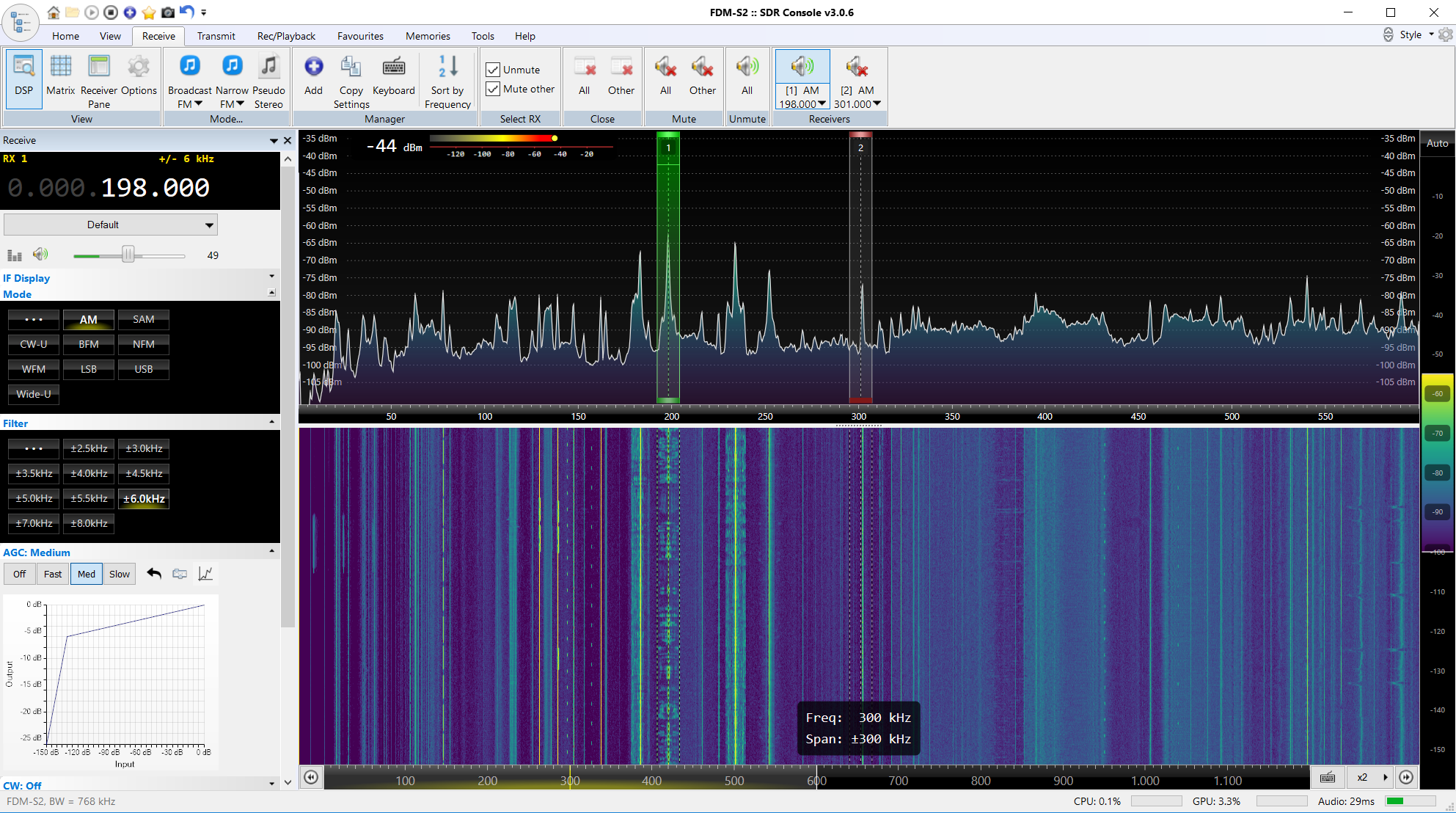
This is quite convenient, both in terms of clarity, and in terms of finding new signals. On the screen you can immediately see, for example, that some station is operating on the right at 100 KHz higher in frequency, various interferences, new and especially short signals, etc. are visible. Signals with a rapidly changing frequency, for example, on a conventional “classical” receiver or transceiver are simply not visible and the person does not even guess their presence.
See what it looks like and listen to what's going on in the air, anyone can open the web-panorama on the Dutch SDR. As an example of a picture from there, the work of the frequency hopping is clearly visible (but this is not accurate).
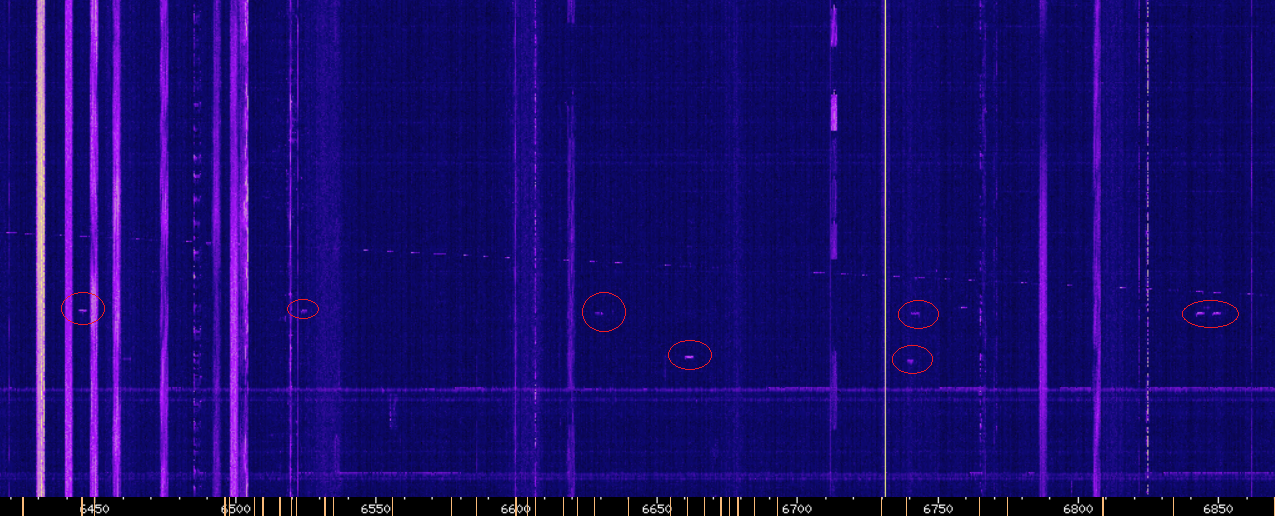
Radio amateurs with experience probably remember the times when narrow-band quartz filters were purchased separately to radio stations, and cost not such small money. The situation is even worse in cheap household receivers - the filters are simpler there, and they aregenerally configured to do nothing with the Chinese randomization, as lucky. And the settings in such receivers are usually only two - Wide and Narrow. In SDR, all filters are mathematically executed, so any width of the filter can be simply selected using the mouse or set in the settings. The rectangularity of the filters can also be almost perfect - mathematically you can choose any order of filters, everything is limited only by the algorithm.
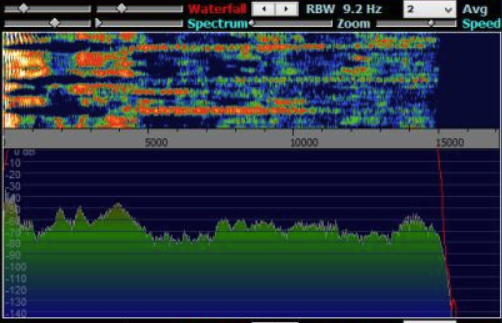
Similarly, noise reduction settings, AGC coefficients, etc. can be set.
By the way, some audiophiles believe that “ordinary” analog filters soundwarmer and lighter than light ones , it's hard for me to say. Perhaps the type of digital filters and affects the perception of sound, there is also a field for experimentation.
SDR is a fairly accurate measuring instrument. Starting from the banal mapping of the levels of different stations in decibels, to evaluating interference, signal quality, etc. All the shortcomings of one’s own or someone’s signal are clearly visible on the spectrum.
For example, in the picture you can see the FM signal. We immediately see who broadcasts where, with what level, which stations interfere with each other.
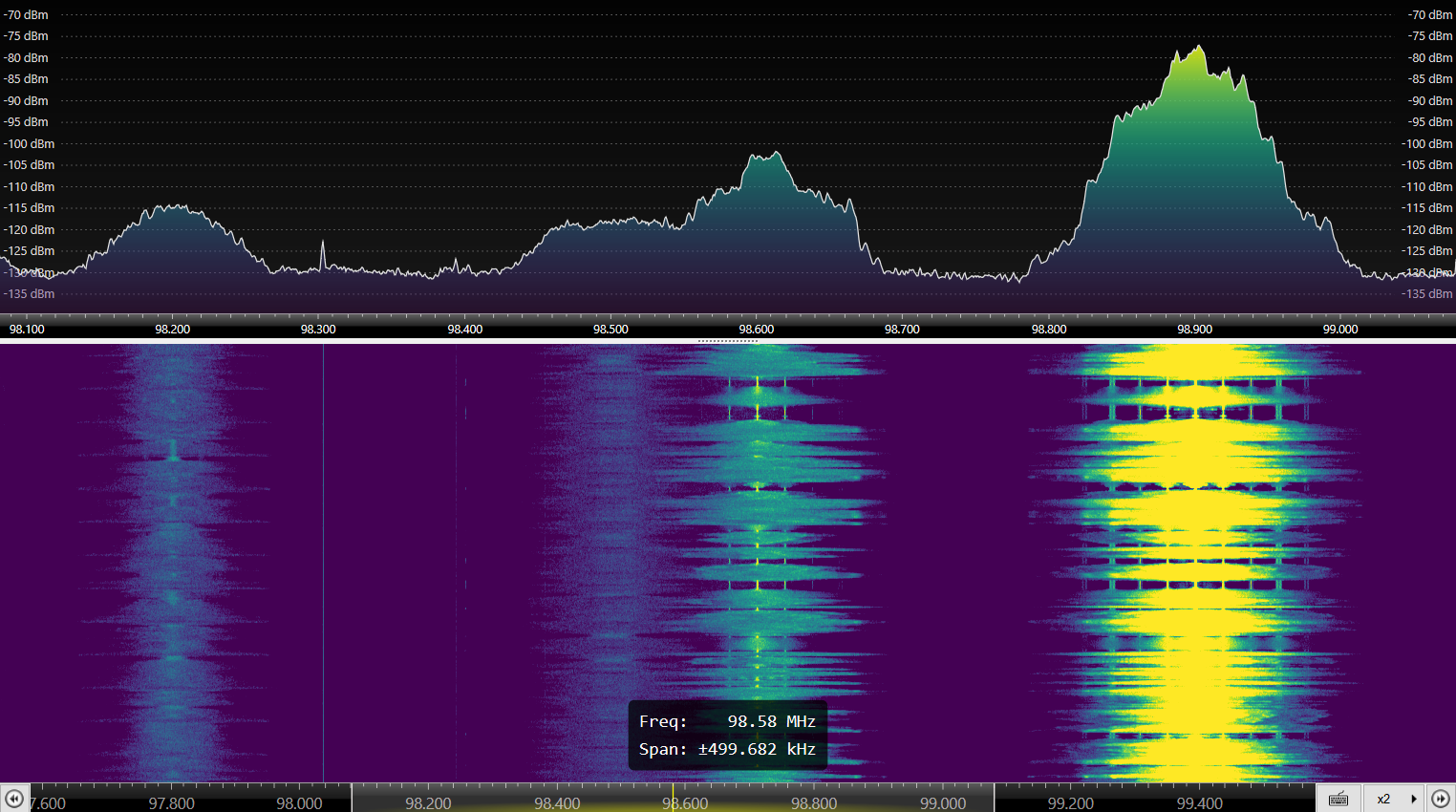
You can also use SDR as a spectrum analyzer.
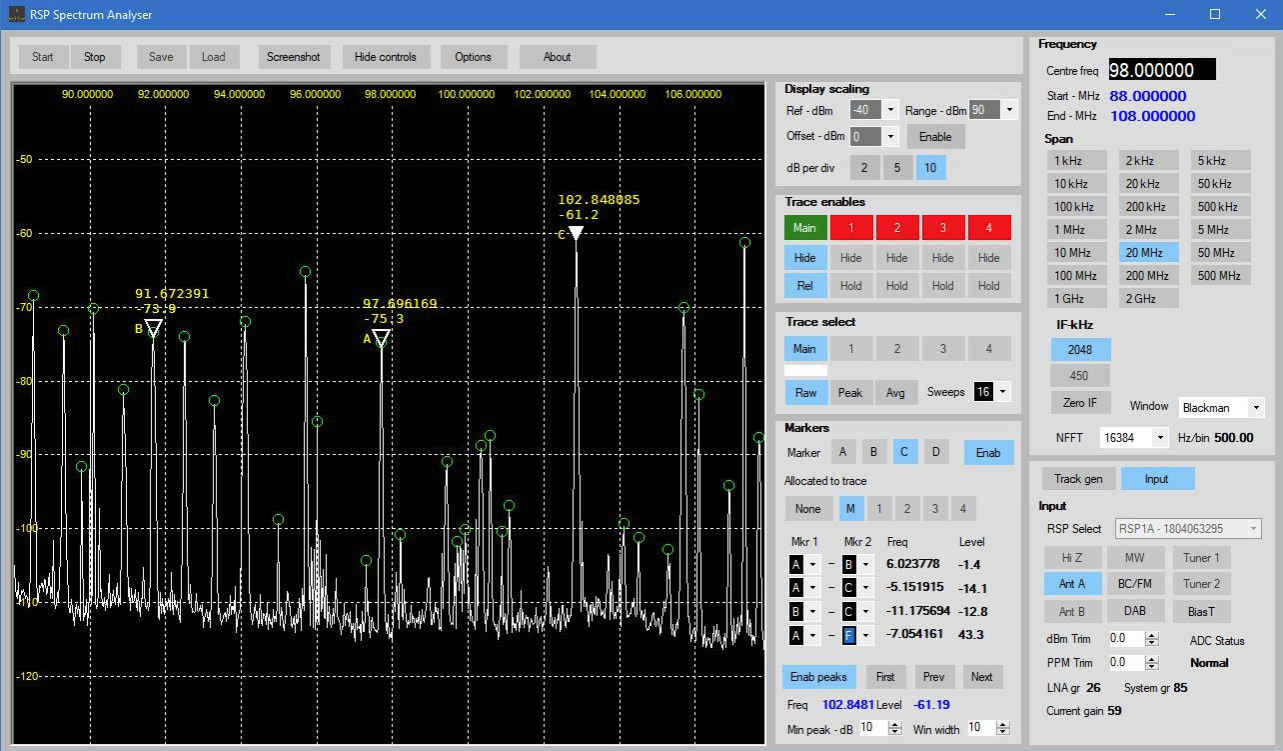
Reception of a signal at once with a wide band of several megahertz opens up amazing possibilities for signal processing. Lovers of Morse code and radio competitions, for example, can decode callsigns at once in a wide band (although, in my opinion, this is unsportsmanlike, but that is another question).
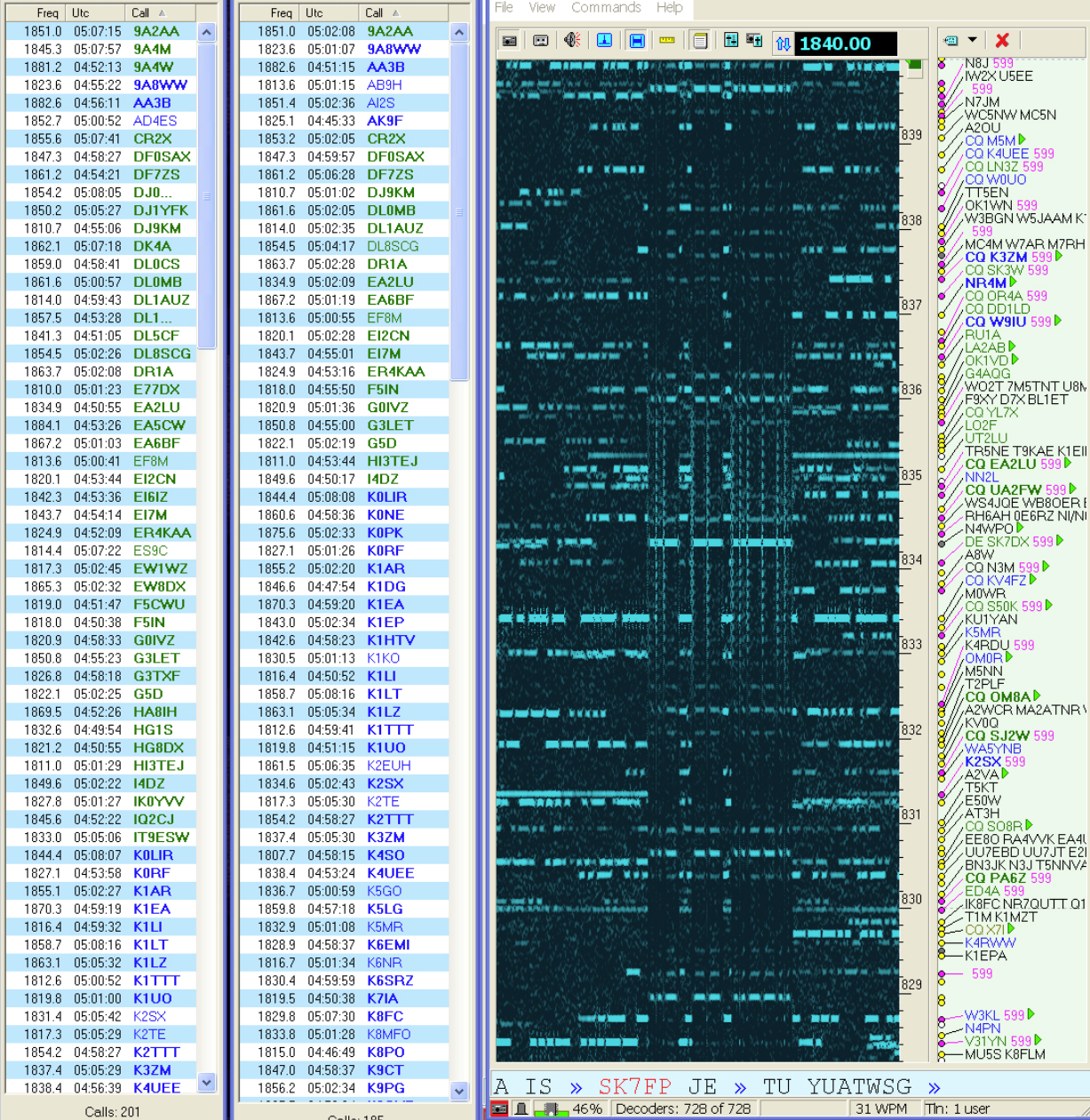
You can also create an unlimited number of "virtual receivers" within the bandwidth. For example, the decoding of amateur radio signals WSPR at once on two bands from one physical receiver is shown.
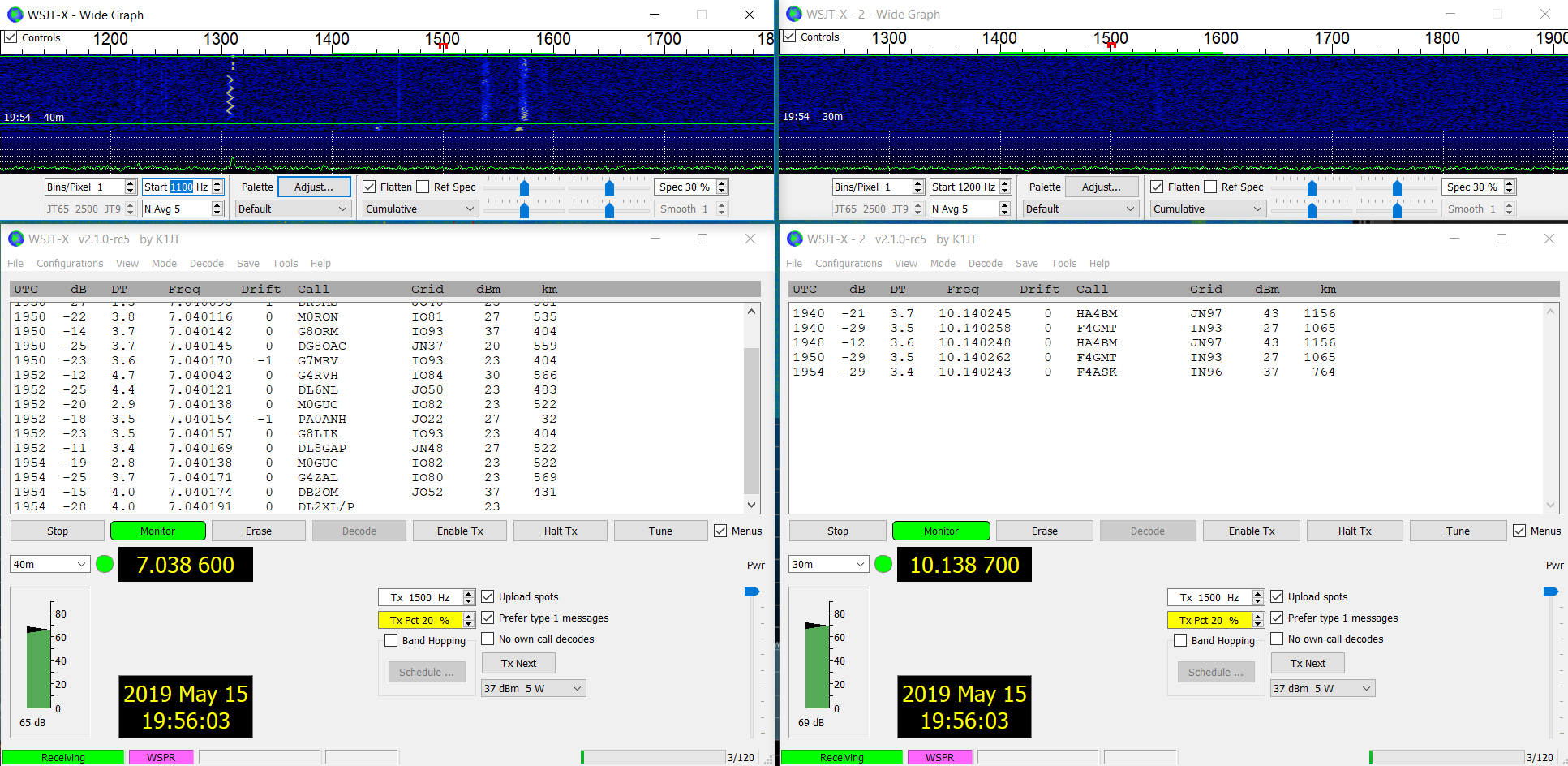
With the help of SDR and Virtual Audio Cable, users with a split personality can listen to two stations at once, one in the right ear and the other in the left;)
It can be assumed that in prof. Wideband processing devices provide great opportunities for searching, classifying, detectingand suppressing various signals. Probably, the technology is actively used in radars and other devices.
Signal processing is done on a PC, so the computational capabilities are limited only by the availability of the necessary decoders. AM, FM, WFM, DRM, DAB +, TETRA and many other scary words - for almost all modern open protocols you can find a decoder.
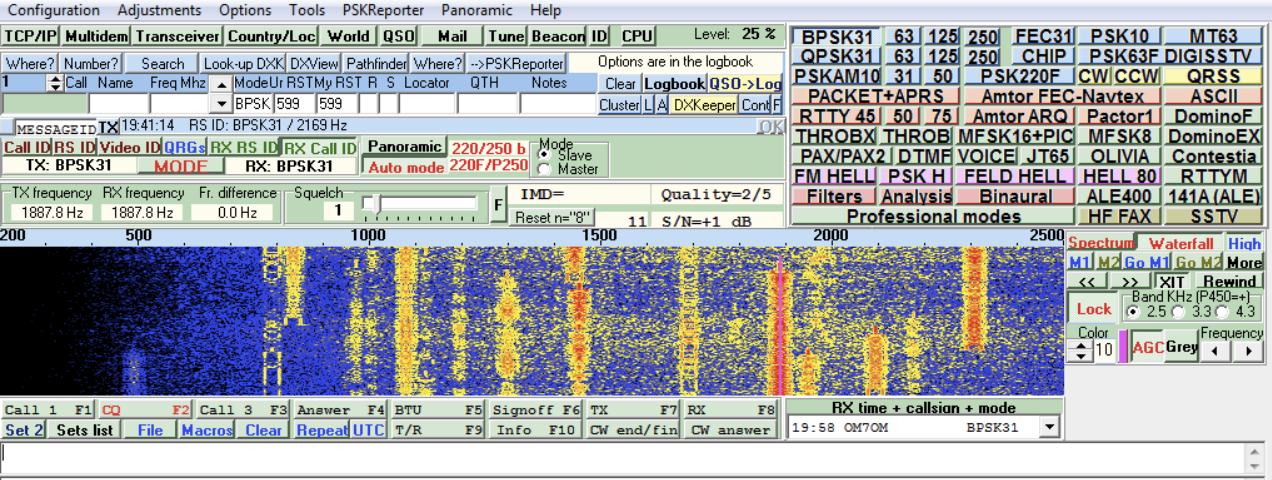
As long as the SDR is too tough, it's probably GSM and WiFi, although there are some progress ( Open BTS , WiFi Analyzer ).
As for the transfer, the owners of URRP or LimeSDR can, for example, experiment with DAB + .
Because In SDR, all data is written initially in a digital format; there is no problem to record the entire band at once, in order to listen or analyze later. A single recording can contain several radio stations at once, which you can listen to in the same way as from a real receiver. This is somewhat similar to a RAW file from a camera, where post-processing (white balance, etc.) can be done after shooting.
The link provides an example of recording with a 760KHz bandwidth, the panorama of which looks like this:

In the record you can find a lot of things at once - a beacon of exact time, telemetry, drive beacons, broadcast stations. You can open it inMatlab free HDSDR program. There is only one drawback, it is a big size. One minute of recording at this bitrate takes 350MB. But of course, with real recordings there is no point in writing everything, you can choose the width of the band depending on the tasks.
Another actively developing direction. Some SDR receivers and transceivers have the ability to work remotely - because the receiver is available by IP-address, there is no fundamental difference, it stands next to the table or 100km at the dacha (of course, the transmission bitrate must be adjusted according to the width of the Internet channel). Given that interference in cities more and more, this can be very relevant.
Of course, with broadband recording and playback, there are great opportunities for debugging various signals, protocols, testing DSP methods, etc. Specialized devices for research purposes (USRP) allow full duplex to work, they can also have several inputs and the ability to synchronize, which allows testing algorithms such as direction finding.
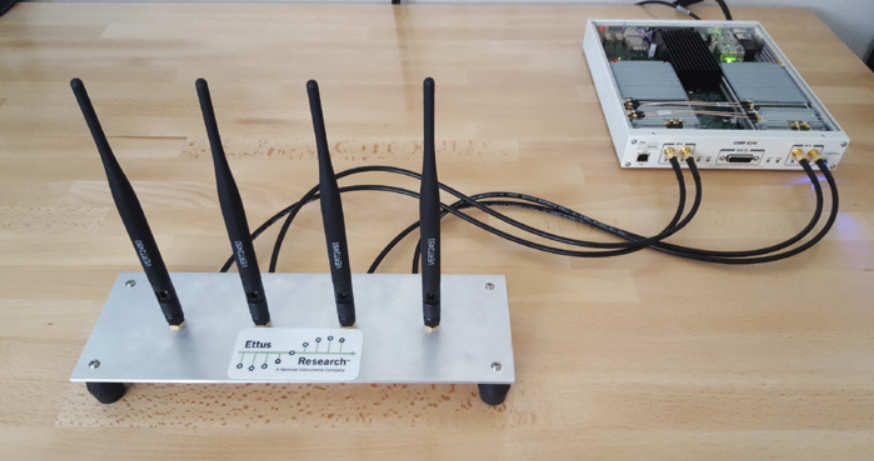
With GNU Radio, you can create and test complex signal processing systems using a large number of pre-built blocks.
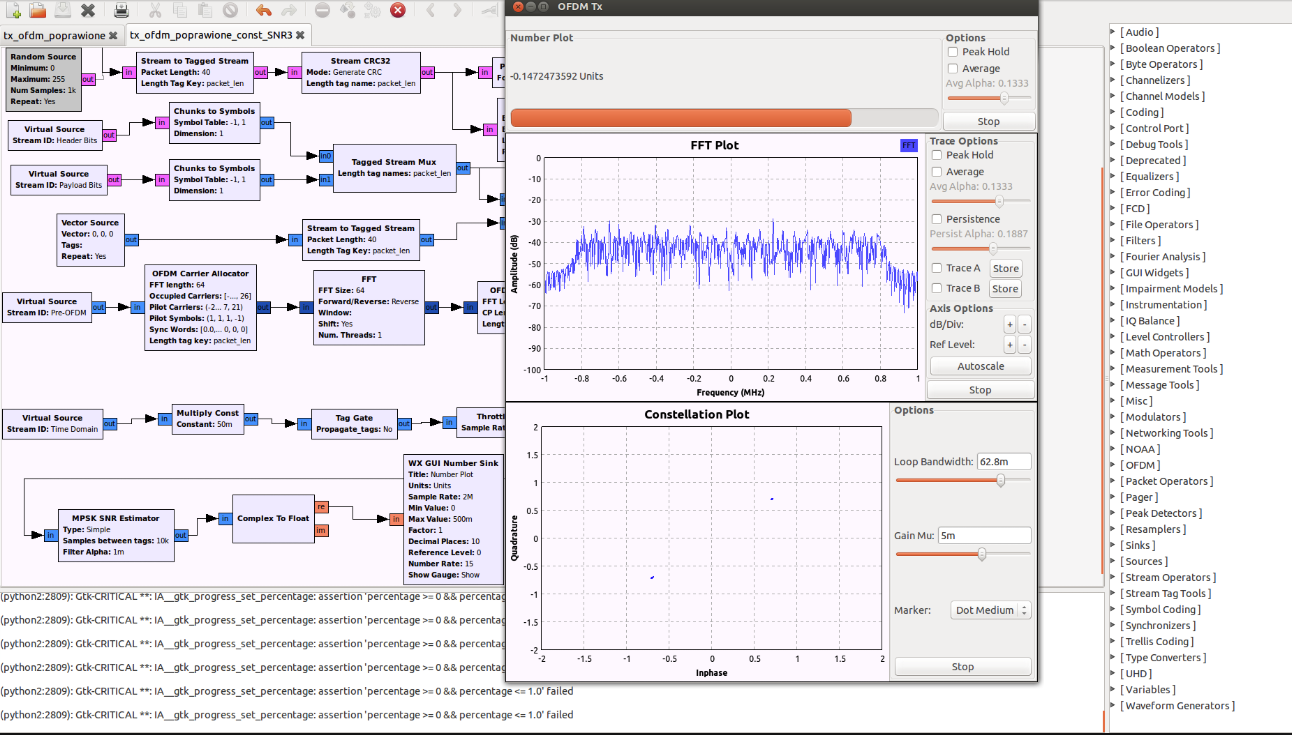
I hope the advantages are clear, let's talk about the disadvantages.
The main drawback for most users is that the SDR is actually a stationary desktop device, which is very inconvenient and uncomfortable to take with it. In cities, alas, the level of interference is often overwhelming, and there are practically no portable receivers with SDR and IQ recording.
In recent years, receivers and transceivers made using SDR technology have begun to appear, but a compact and lightweight device that could simply be taken with you while it is not on the market. Of course, if you wish, you can take with you a laptop, SDR, antenna, wires, adapters, powerbank, but all this is rather cumbersome and inconvenient. The market for portable SDR devices does not yet exist de facto. Of the exceptions, except that the RDR-Pocket , but its price is about 1500Euro, and it is produced only on order. Modern technologies quite allow to make such devices, but they simply do not have effective demand.
As is obvious from the description, a good SDR is a fairly expensive device. Ultra-fast ADCs and FPGAs, low-noise input cascades, multi-layer printed circuit boards, high-quality filters, etc. — the price of good DDC SDR starts at $ 500 and up, and you can’t do it cheaply. Professional receivers (USRP, Winradio) cost from $ 1500 and above.
However, there is progress here too. Quite good SDRPlay receivers with a range from 10KHz to 2GHz are sold for $ 150, and although this is not DDC and ADC only 12bit, but for most tasks it has enough reception. The “whistles” of the $ 30 RTL-SDR probably already belong to every radio amateur. For lovers of VHF and signal processing, there are inexpensive LimeSDR, which at a price of $ 200-300 cover the range up to 6 GHz.
It is clear that serious algorithms of digital signal processing are “hidden” behind the external simplicity and convenience. Over the past 10 years, a large number of various software for SDR has been created, and most likely the average user will not have to add anything. But if you want to fix something or create your own, it is not so easy to do, the “entry threshold” is quite large.
It is also obvious that the current consumption is quite high, as well as the requirements for the CPU and video card. A regular “classic” radio receiver can run for a month on batteries, DDC SDR will consume at least 1-2A during operation.
In the previous part, some wondered why this was needed at all, I hope that I was partially able to answer this question.
All that was planned, in one article again did not fit. In the next part we will look at the software interface to the SDR receiver in Python, and perhaps a bit of work with GNU Radio.
In the first part , the main types of SDR devices were described and their characteristics were briefly described. In the second part I will tell you more about the pros and cons of SDR, examples of the use of this technology will also be given.

')
Continued under the cut (caution, traffic).
If someone missed the first part , it is advisable to start with it in order to better understand what it is about.
Advantages of SDR
First, let's talk about the advantages of SDR, what they give to the user. It is clear that everyone’s priorities are different, therefore different points are mixed. It is difficult to say which of them is “more important”, but it’s probably impossible, everyone will decide for himself.
Panoramic overview of the air
The first, and most obvious, SDR shows the panorama of the radio broadcast "as is".

This is quite convenient, both in terms of clarity, and in terms of finding new signals. On the screen you can immediately see, for example, that some station is operating on the right at 100 KHz higher in frequency, various interferences, new and especially short signals, etc. are visible. Signals with a rapidly changing frequency, for example, on a conventional “classical” receiver or transceiver are simply not visible and the person does not even guess their presence.
See what it looks like and listen to what's going on in the air, anyone can open the web-panorama on the Dutch SDR. As an example of a picture from there, the work of the frequency hopping is clearly visible (but this is not accurate).

Adjustable digital filters and sound effects
Radio amateurs with experience probably remember the times when narrow-band quartz filters were purchased separately to radio stations, and cost not such small money. The situation is even worse in cheap household receivers - the filters are simpler there, and they are

Similarly, noise reduction settings, AGC coefficients, etc. can be set.
By the way, some audiophiles believe that “ordinary” analog filters sound
Measurement capability
SDR is a fairly accurate measuring instrument. Starting from the banal mapping of the levels of different stations in decibels, to evaluating interference, signal quality, etc. All the shortcomings of one’s own or someone’s signal are clearly visible on the spectrum.
For example, in the picture you can see the FM signal. We immediately see who broadcasts where, with what level, which stations interfere with each other.

You can also use SDR as a spectrum analyzer.

Broadband processing
Reception of a signal at once with a wide band of several megahertz opens up amazing possibilities for signal processing. Lovers of Morse code and radio competitions, for example, can decode callsigns at once in a wide band (although, in my opinion, this is unsportsmanlike, but that is another question).

You can also create an unlimited number of "virtual receivers" within the bandwidth. For example, the decoding of amateur radio signals WSPR at once on two bands from one physical receiver is shown.

With the help of SDR and Virtual Audio Cable, users with a split personality can listen to two stations at once, one in the right ear and the other in the left;)
It can be assumed that in prof. Wideband processing devices provide great opportunities for searching, classifying, detecting
Reception and transmission of almost any modulation
Signal processing is done on a PC, so the computational capabilities are limited only by the availability of the necessary decoders. AM, FM, WFM, DRM, DAB +, TETRA and many other scary words - for almost all modern open protocols you can find a decoder.

As long as the SDR is too tough, it's probably GSM and WiFi, although there are some progress ( Open BTS , WiFi Analyzer ).
As for the transfer, the owners of URRP or LimeSDR can, for example, experiment with DAB + .
Broadband recording and playback
Because In SDR, all data is written initially in a digital format; there is no problem to record the entire band at once, in order to listen or analyze later. A single recording can contain several radio stations at once, which you can listen to in the same way as from a real receiver. This is somewhat similar to a RAW file from a camera, where post-processing (white balance, etc.) can be done after shooting.
The link provides an example of recording with a 760KHz bandwidth, the panorama of which looks like this:

In the record you can find a lot of things at once - a beacon of exact time, telemetry, drive beacons, broadcast stations. You can open it in
Remote work
Another actively developing direction. Some SDR receivers and transceivers have the ability to work remotely - because the receiver is available by IP-address, there is no fundamental difference, it stands next to the table or 100km at the dacha (of course, the transmission bitrate must be adjusted according to the width of the Internet channel). Given that interference in cities more and more, this can be very relevant.
Engineering and research tasks
Of course, with broadband recording and playback, there are great opportunities for debugging various signals, protocols, testing DSP methods, etc. Specialized devices for research purposes (USRP) allow full duplex to work, they can also have several inputs and the ability to synchronize, which allows testing algorithms such as direction finding.

With GNU Radio, you can create and test complex signal processing systems using a large number of pre-built blocks.

I hope the advantages are clear, let's talk about the disadvantages.
SDR Disadvantages
Only stationary work
The main drawback for most users is that the SDR is actually a stationary desktop device, which is very inconvenient and uncomfortable to take with it. In cities, alas, the level of interference is often overwhelming, and there are practically no portable receivers with SDR and IQ recording.
In recent years, receivers and transceivers made using SDR technology have begun to appear, but a compact and lightweight device that could simply be taken with you while it is not on the market. Of course, if you wish, you can take with you a laptop, SDR, antenna, wires, adapters, powerbank, but all this is rather cumbersome and inconvenient. The market for portable SDR devices does not yet exist de facto. Of the exceptions, except that the RDR-Pocket , but its price is about 1500Euro, and it is produced only on order. Modern technologies quite allow to make such devices, but they simply do not have effective demand.
Price
As is obvious from the description, a good SDR is a fairly expensive device. Ultra-fast ADCs and FPGAs, low-noise input cascades, multi-layer printed circuit boards, high-quality filters, etc. — the price of good DDC SDR starts at $ 500 and up, and you can’t do it cheaply. Professional receivers (USRP, Winradio) cost from $ 1500 and above.
However, there is progress here too. Quite good SDRPlay receivers with a range from 10KHz to 2GHz are sold for $ 150, and although this is not DDC and ADC only 12bit, but for most tasks it has enough reception. The “whistles” of the $ 30 RTL-SDR probably already belong to every radio amateur. For lovers of VHF and signal processing, there are inexpensive LimeSDR, which at a price of $ 200-300 cover the range up to 6 GHz.
The complex algorithmic part
It is clear that serious algorithms of digital signal processing are “hidden” behind the external simplicity and convenience. Over the past 10 years, a large number of various software for SDR has been created, and most likely the average user will not have to add anything. But if you want to fix something or create your own, it is not so easy to do, the “entry threshold” is quite large.
Power and processor requirements
It is also obvious that the current consumption is quite high, as well as the requirements for the CPU and video card. A regular “classic” radio receiver can run for a month on batteries, DDC SDR will consume at least 1-2A during operation.
Conclusion
In the previous part, some wondered why this was needed at all, I hope that I was partially able to answer this question.
All that was planned, in one article again did not fit. In the next part we will look at the software interface to the SDR receiver in Python, and perhaps a bit of work with GNU Radio.
Source: https://habr.com/ru/post/452036/
All Articles